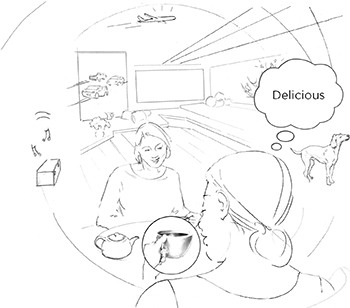
IN THIS chapter, I introduce a basic, conceptual model of Conscious Experience. You can consider this a map of the topography—the landscape of the mind, so to speak. The meditation instructions are like the roads allowing you to explore this landscape comfortably. However, remember that a map is only a representation, not the thing itself. When circumstances change—as your practice improves—you’ll find yourself wanting a new map. This is why, in later chapters, I provide two additional, much more in-depth models of the mind for you to work from. Each map builds on the previous ones, and together they lead you toward the two major objectives of meditation practice: stable attention and mindfulness, both of which we will look at more closely in this Interlude.
Consciousness1 consists of whatever we’re experiencing in the moment. It’s a lot like vision: just as the objects in our field of vision change from one moment to the next, objects in our field of conscious awareness, like sights, sounds, smells, and other external phenomena, also arise and pass away. Of course, this field isn’t just limited to what we perceive with our outer senses. It also includes internal mental objects, which come in the form of transitory thoughts, feelings, and memories.
Conscious experience takes two different forms, attention and peripheral awareness. Whenever we focus our attention on something, it dominates our conscious experience. At the same time, however, we can be more generally aware of things in the background. For example, right now your attention is focused on what you’re reading. At the same time you’re also aware of other sights, sounds, smells, and sensations in the periphery.
The way attention and peripheral awareness work together is a lot like the relationship between visual focus and peripheral vision. Try fixing your eyes on an external object. You will notice that, as you focus on the object, your peripheral vision takes in other information elsewhere in your field of vision. You can compare that with your experience of attention and peripheral awareness in daily life, where you pay attention to some things while remaining peripherally aware of others. For instance, you may be listening intently to what a person is saying. At the same time, you’re peripherally aware of the flavor of the tea you’re drinking, traffic noises in the background, and the pleasant feelings of sitting in a cozy chair. Just as with vision, we’re more fully conscious of the object in the focus of our attention, but we remain conscious of the many objects in peripheral awareness as well. When we shift our focus, what had been at the center of attention moves to the periphery. As attention moves from one object to another—from the conversation to the mug of tea—we become more fully conscious of each object in turn, while remaining peripherally aware of the others.
It’s important to realize attention and peripheral awareness are two different ways of “knowing” the world.2 Each has its virtues as well as its shortcomings. Attention singles out some small part of the content of the field of conscious awareness from the rest in order to analyze and interpret it. On the other hand, peripheral awareness is more holistic, open, and inclusive, and provides the overall context for conscious experience. It has more to do with the relationships of objects to one another and to the whole. In this book, whenever the term awareness is used, it refers to peripheral awareness. It never means attention.3 The distinction between the two is key. The failure to recognize this distinction creates considerable confusion.
You work with attention and peripheral awareness to cultivate stable attention and mindfulness—the two main objectives of meditation.
In meditation, we work with both attention and peripheral awareness to cultivate stable attention and mindfulness, the two main practice objectives of meditation.

When you shift that focus, from the conversation to the mug of tea, you become more fully conscious of each object in turn, while remaining peripherally aware of the others.